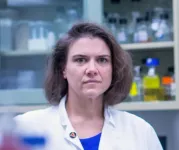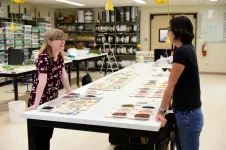(Press-News.org) A scientist from HSE University has developed an image recognition algorithm that works 40% faster than analogues. It can speed up real-time processing of video-based image recognition systems. The results of the study have been published in the journal Information Sciences.
Convolutional neural networks (CNNs), which include a sequence of convolutional layers, are widely used in computer vision. Each layer in a network has an input and an output. The digital description of the image goes to the input of the first layer and is converted into a different set of numbers at the output. The result goes to the input of the next layer and so on until the class label of the object in the image is predicted in the last layer. For example, this class can be a person, a cat, or a chair. For this, a CNN is trained on a set of images with a known class label. The greater the number and variability of the images of each class in the dataset are, the more accurate the trained network will be.
If there are only a few examples in the training set, the additional training (fine-tuning) of the neural network is used. CNN is trained to recognize images from a similar dataset that solves the original problem. For example, when a neural network learns to recognize faces or their attributes (emotions, gender, age), it is preliminary trained to identify celebrities from their photos. The resulting neural network is then fine-tuned on the available small dataset to identify the faces of family or relatives in home video surveillance systems. The more depth (number) of layers there are in a CNN, the more accurately it predicts the type of object in the image. However, if the number of layers is increased, more time is required to recognize objects.
The study's author, Professor Andrey Savchenko of the HSE Campus in Nizhny Novgorod, was able to speed up the work of a pre-trained convolutional neural network with arbitrary architecture, consisting of 90-780 layers in his experiments. The result was an increase in recognition speed of up to 40%, while controlling the loss in accuracy to no more than 0.5-1%. The scientist relied on statistical methods such as sequential analysis and multiple comparisons (multiple hypothesis testing).
"The decision in the image recognition problem is made by a classifier -- a special mathematical algorithm that receives an array of numbers (features/embeddings of an image) as inputs, and outputs a prediction about which class the image belongs to. The classifier can be applied by feeding it the outputs of any layer of the neural network. To recognize "simple" images, the classifier only needs to analyse the data (outputs) from the first layers of the neural network.
There is no need to waste further time if we are already confident in the reliability of the decision made. For "complex" pictures, the first layers are clearly not enough -- you need to move on to the next. Therefore, classifiers were added to the neural network into several intermediate layers. Depending on the complexity of the input image, the proposed algorithm decided whether to continue recognition or complete it. Since it is important to control errors in such a procedure, I applied the theory of multiple comparisons: I introduced many hypotheses, at which intermediate layer to stop, and sequentially tested these hypotheses," explained Professor Savchenko.
If the first classifier already produced a decision that was considered reliable by the multiple hypothesis testing procedure, the algorithm stopped. If the decision was declared unreliable, the calculations in the neural network continued to the intermediate layer, and the reliability check was repeated.
As the scientist notes, the most accurate decisions are obtained for the outputs of the last layers of the neural network. Early network outputs are classified much faster, which means it is necessary to simultaneously train all classifiers in order to accelerate recognition while controlling loss in accuracy. For example, so that the error due to an earlier stop is no more than 1%.
"High accuracy is always important for image recognition. For example, if a decision in face recognition systems is made incorrectly, then either someone outside can gain access to confidential information or conversely the user will be repeatedly denied access, because the neural network cannot identify him correctly. Speed ??can sometimes be sacrificed, but it matters, for example, in video surveillance systems, where it is highly desirable to make decisions in real time, that is, no more than 20-30 milliseconds per frame. To recognize an object in a video frame here and now, it is very important to act quickly, without losing accuracy," said Professor Savchenko.
INFORMATION:
Wastewater testing is an effective way to identify new cases of COVID-19 in nursing homes and other congregate living settings, and it may be particularly useful for preventing outbreaks in college dormitories, a new University of Virginia study finds.
The research, a collaboration of UVA's School of Medicine and School of Engineering, was led by UVA Health's Amy Mathers, MD. It offers some of the first clear guidance on the most effective methods to perform testing to detect COVID-19 in wastewater.
The researchers evaluated and compared sampling and analysis techniques by testing them within buildings with known numbers of positive cases. They were then able to determine wastewater testing's strengths and limitations as a tool for monitoring COVID-19 in a building population. ...
SASKATOON - Tepary beans--a high protein legume common to the southwest United States and Mexico--may hold the key to adapting bean crops for the increasingly harsh conditions brought on by a changing climate, according to research led by University of Saskatchewan (USask) and Michigan State University.
In a study just published in Nature Communications, the researchers found that as the mercury rises to 27oC at night--a temperature devastating for current bean crops--specific genes sensitive to heat stress in the tepary bean get activated, protecting the plant. ...
The investigators used machine learning to predict which patients might get worse and not respond positively to being turned onto their front in intensive care units (ICUs) - a technique known as proning that is commonly used in this setting to improve oxygenation of the lungs.
While the AI model was used on a retrospective cohort of patient data collected during the pandemic's first wave, the study demonstrates the ability of AI methods to predict patient outcomes using routine clinical information used by ICU medics.
The researchers say the approach, where each patient's ...
Alexandria, Va., USA -- Carbon dioxide (CO2) is a byproduct of human metabolism and exists in high levels in exhaled air, and is therefore often used as a proxy for indoor air quality. The study "Ventilation Assessment by Carbon Dioxide Levels in Dental Treatment Rooms," published in the Journal of Dental Research (JDR), evaluated CO2 levels in dental operatories and determined the accuracy of using CO2 levels to assess ventilation rate in dental clinics.
Researchers at the University of Rochester, Eastman Institute for Oral Health, N.Y., USA, conducted CO2 concentration and ventilation rate assessments in 10 closed dental treatment rooms with varying ...
Roads can be barriers to wildlife of all sorts, and scientists have studied road impacts on animals ranging from Florida panthers and grizzly bears to box turtles, mice, rattlesnakes and salamanders.
But much less is known about the impact of roads on pollinating insects such as bees and to what extent these structures disrupt insect pollination, which is essential to reproduction in many plant species.
In a paper published online May 10 in the Journal of Applied Ecology, University of Michigan researchers describe how they used fluorescent pigment as an analog for pollen. They applied the luminous pigment to ...
(Boston)--Chronic Obstructive Pulmonary Disease (COPD) is a disease caused by cigarette smoking that reduces lung function and causes difficulty breathing. It is the third leading cause of death worldwide. Current treatments for COPD only affect symptoms, not progression. Identifying who is going to get COPD before they get it is key to figuring out how to intercept the disease at an early stage.
Researchers from Boston University School of Medicine (BUSM) have identified a panel of genes that are active in smokers and ex-smokers who experience faster loss of lung function over time. They believe these genes could be useful to predict which people are most at risk for smoking-related ...
(Boston)--Knee osteoarthritis (OA) is a global health problem. Almost half the adults over the age of 75 have some form of knee OA--one of the leading causes of disability worldwide. Because there is no cure for knee OA, current treatment relies on accurately identifying and staging the disease.
Using an Artificial Intelligence-based approach known as deep learning, researchers from Boston University School of Medicine (BUSM) have now identified a new measure to determine the severity of knee osteoarthritis--named "subchondral bone length" (SBL).
There are only a handful of proven imaging markers of knee OA. Currently, medical imaging tools such as Magnetic ...
DALLAS - April 30, 2021 - UT Southwestern scientists successfully employed a new type of gene therapy to treat mice with Duchenne muscular dystrophy (DMD), uniquely utilizing CRISPR-Cas9-based tools to restore a large section of the dystrophin protein that is missing in many DMD patients. The approach, described online today in the journal Science Advances, could lead to a treatment for DMD and inform the treatment of other inherited diseases.
"Thousands of different mutations causing Duchenne have been identified, but they tend to cluster into certain parts of the dystrophin gene," says study leader END ...
University of Miami Miller School of Medicine researchers are the first to demonstrate that COVID-19 can be present in the penis tissue long after men recover from the virus.
The widespread blood vessel dysfunction, or endothelial dysfunction, that results from the COVID-19 infection could then contribute to erectile dysfunction, or ED, according to the study recently published in the World Journal of Men's Health. Endothelial dysfunction is a condition in which the lining of the small blood vessels fails to perform all of its functions normally. As a result, the tissues ...
Researchers have mapped out the changes in metabolism that occur after a heart attack, publishing their findings today in the open-access eLife journal.
Their study in mice reveals certain genes and metabolic processes that could aid or hinder recovery, and might be good targets for treatments to prevent damage after a heart attack.
"Although some studies have looked at how changes in individual body tissues underlie mechanisms of disease, the crosstalk between different tissues and their dysregulation has not been examined in heart attacks or other cardiovascular-related complications," explains first author Muhammad Arif, a PhD student at KTH Royal ...



